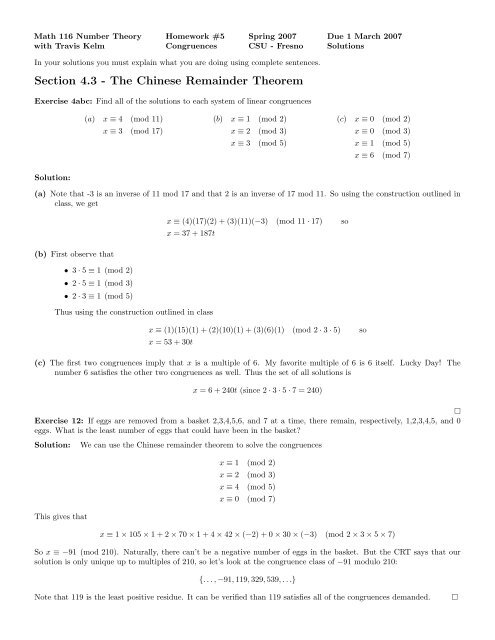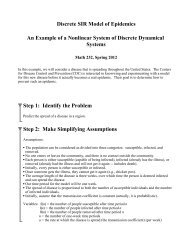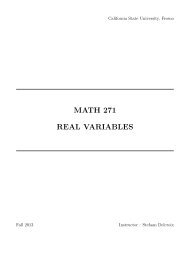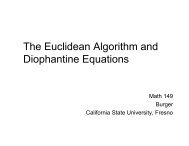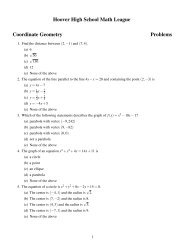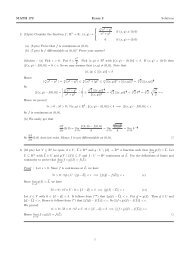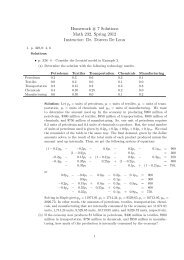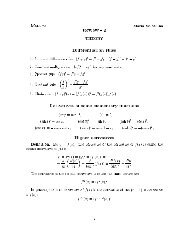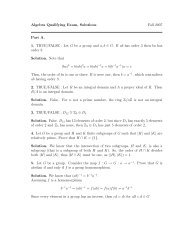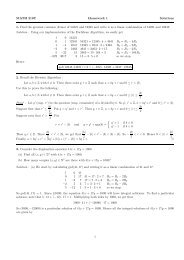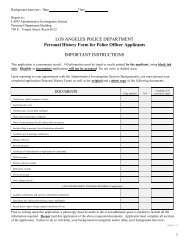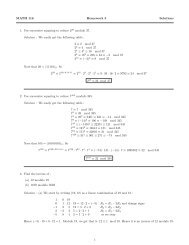Section 4.3 - The Chinese Remainder Theorem
Section 4.3 - The Chinese Remainder Theorem
Section 4.3 - The Chinese Remainder Theorem
- No tags were found...
You also want an ePaper? Increase the reach of your titles
YUMPU automatically turns print PDFs into web optimized ePapers that Google loves.
Math 116 Number <strong>The</strong>ory Homework #5 Spring 2007 Due 1 March 2007with Travis Kelm Congruences CSU - Fresno SolutionsIn your solutions you must explain what you are doing using complete sentences.<strong>Section</strong> <strong>4.3</strong> - <strong>The</strong> <strong>Chinese</strong> <strong>Remainder</strong> <strong>The</strong>oremExercise 4abc: Find all of the solutions to each system of linear congruences(a) x ≡ 4 (mod 11) (b) x ≡ 1 (mod 2) (c) x ≡ 0 (mod 2)x ≡ 3 (mod 17) x ≡ 2 (mod 3) x ≡ 0 (mod 3)x ≡ 3 (mod 5) x ≡ 1 (mod 5)x ≡ 6 (mod 7)Solution:(a) Note that -3 is an inverse of 11 mod 17 and that 2 is an inverse of 17 mod 11. So using the construction outlined inclass, we get(b) First observe that• 3 · 5 ≡ 1 (mod 2)• 2 · 5 ≡ 1 (mod 3)• 2 · 3 ≡ 1 (mod 5)x ≡ (4)(17)(2) + (3)(11)(−3) (mod 11 · 17) sox = 37 + 187tThus using the construction outlined in classx ≡ (1)(15)(1) + (2)(10)(1) + (3)(6)(1) (mod 2 · 3 · 5) sox = 53 + 30t(c) <strong>The</strong> first two congruences imply that x is a multiple of 6. My favorite multiple of 6 is 6 itself. Lucky Day! <strong>The</strong>number 6 satisfies the other two congruences as well. Thus the set of all solutions isx = 6 + 240t (since 2 · 3 · 5 · 7 = 240)□Exercise 12: If eggs are removed from a basket 2,3,4,5,6, and 7 at a time, there remain, respectively, 1,2,3,4,5, and 0eggs. What is the least number of eggs that could have been in the basket?Solution:We can use the <strong>Chinese</strong> remainder theorem to solve the congruencesx ≡ 1 (mod 2)x ≡ 2 (mod 3)x ≡ 4 (mod 5)x ≡ 0 (mod 7)This gives thatx ≡ 1 × 105 × 1 + 2 × 70 × 1 + 4 × 42 × (−2) + 0 × 30 × (−3) (mod 2 × 3 × 5 × 7)So x ≡ −91 (mod 210). Naturally, there can’t be a negative number of eggs in the basket. But the CRT says that oursolution is only unique up to multiples of 210, so let’s look at the congruence class of −91 modulo 210:{. . . , −91, 119, 329, 539, . . .}Note that 119 is the least positive residue. It can be verified than 119 satisfies all of the congruences demanded.□
Exercise 18: Does the systemhave a solution? Be sure to explain why or why not.Solution:x ≡ 1 (mod 8)x ≡ 3 (mod 9)x ≡ 2 (mod 12)Since 8 and 9 are relatively prime, we can use the <strong>Chinese</strong> remainder theorem to solve the congruencesx ≡ 1 (mod 8)x ≡ 3 (mod 9)One comes up with x ≡ 57 (mod 72). Thus since 12 divides 72, we must also have x ≡ 57 (mod 12). But 57 ≢ 2 (mod 12)thus there can be no solutions to this system of congruences.□<strong>Section</strong> 5.1 - Divisibility TestsExercise *: Invent your own divisibility tests for 37, 101, and 33. I will give extra points for tests that I find especiallyinventive or useful.Solution: Here are the ones that I thought of. <strong>The</strong>y are all basically the same. (It was late and I was not feelingespecially creative when I was typing these solutions.)(37) Since 1000 ≡ 1 (mod 37), given a number n, starting from the ones digit, break n into chunks of three digits. <strong>The</strong>nadd all these three digit numbers together. <strong>The</strong> 3-chunk sum is divisible by 37 if and only if n is divisible by 37.(101) Since 100 ≡ −1 (mod 101), given a number n, starting from the ones digit, break n into chunks consisting of twodigits. <strong>The</strong>n find the alternating sum of these two digit numbers. This alternating sum is divisible by 101 if andonly if n is divisible by 101.(33) Since 100 ≡ 1 (mod 33), given a number n, starting from the ones digit, break n into chunks consisting of two digits.<strong>The</strong>n find the sum of these two digit numbers. This sum is divisible by 33 if and only if n is divisible by 33.<strong>Section</strong> 6.1 - Wilson’s <strong>The</strong>orem and Fermat’s Little <strong>The</strong>orem□Exercise 4: Find the remainder when 5!25! is divided by 31.Solution:Suppose that x ≡ 5! 25! (mod 31). Multiply both sides by (26)(27)(28)(29)(30) to get(26)(27)(28)(29)(30)x ≡ 5! 30! (mod 31)Using Wilson’s theorem we then get (26)(27)(28)(29)(30)x ≡ −(5!) (mod 31). Note then that 26 ≡ −5, 27 ≡ −4, . . . , 30 ≡−1 (mod 31) so we actually have(−5)(−4)(−3)(−2)(−1)x ≡ −(5!) (mod 31) or−120x ≡ −120−4x ≡ −432x ≡ 32x ≡ 1multiply both sides by −8Thus the remainder is 1 when 5! 25! is divided by 31.□
Exercise 6: Find the remainder when 7 × 8 × 9 × 15 × 16 × 17 × 23 × 24 × 25 × 43 is divided by 11.Solution:When we put on our mod 11 goggles we have15 ≡ 4 16 ≡ 5 17 ≡ 6 23 ≡ 124 ≡ 2 25 ≡ 3 43 ≡ 10Thus7 × 8 × 9 × 15 × 16 × 17 × 23 × 24 × 25 × 43 ≡ 10!≡ −1 (mod 11) using Wilson’s theoremThus the remainder is 10 when 7 × 8 × 9 × 15 × 16 × 17 × 23 × 24 × 25 × 43 is divided by 11.□Exercise 12: Use Fermat’s Little <strong>The</strong>orem to find the least positive residue of 2 106 modulo 7.Solution:Note that 10 6 = 6(166,666) + 4. By Fermat’s little theorem we have that 2 6 ≡ 1 (mod 7). This gives2 106 = (2 6 ) 166,666 2 4 ≡ 2 4 ≡ 2 (mod 7)So 2 is the least positive residue of 2 106 modulo 7. □Exercise 16: Show that if n is composite integer other than 4, then (n − 1)! ≡ 0 (mod n).Solution: Before we begin we should take note of the easy fact that if a|n then a ≤ (n − 1). Hence if a|n then a|(n − 1)!.Also note that to show (n − 1)! ≡ 0 (mod n) it suffices to demonstrate that n divides (n − 1)!. This is what we will do.Let p be a prime factor of n. Since n is composite n = pc where c ≠ 1. If c ≠ p then we are done as p and c are twodistinct divisors of n, and hence two distinct divisors of (n − 1)!. Thus n = pc divides (n − 1)! as desired.If c = p then we have that n = p 2 . Since we are assuming that n ≠ 4 we must have that p ≠ 2. Thus observe thatp and 2p are both less than p 2 = n and hence p and 2p are distinct factors of (n − 1)!. Thus p(2p) = 2p 2 = 2n divides(n − 1)!. It follows that n divides (n − 1)! as desired.□


